So I made a mesh in Maya, wrote some code to import it into the vertex buffer and so far so good but the mesh has multiple components that have different textures assigned and I figured thats easy ill put a key in the vertbuffer and run a switch statement (and from what i can gather from this post thats not such a bad thing) and send the required textures for the whole mesh through uniforms and have them selected through the key but as i was implementing it i noticed it would require multiple sampler2D's and was wondering if this would entail loading multiple mostly unused textures every pixel and would this be a waste?
GLchar* MeshFragmentShader = //also known as pixel shader
"#version 330 core\n" //version 3, not 440 >> 450
"\n" //GLSL 3, core = non-depricated
"layout(location = 0) out vec4 color;\n"
"\n"
"in vec2 v_TexCoord;\n"
"in vec4 v_color;\n"
"in float v_lightval;\n"
"\n"
"uniform sampler2D u_Texture;\n"//<<multiple samplers?
"\n"
"void main()\n"
"{\n"
" int i = 0;\n"//<<texture/color key (location = 4) Vertbuffer
" vec4 texColor; \n"
" switch (i) {\n"
" case 0:\n"
" texColor = texture(u_Texture, v_TexCoord);\n"
" break;\n"
" case 20:\n"
" texColor = v_color;\n"//<<override
" break;\n"
" } \n"
//" texColor = texture(u_Texture, v_TexCoord); \n"
" \n"//simple code certainly somthing i would like to improve
" vec3 Kolor = texColor.rgb * (v_lightval + 0.4f);\n"//change 0.4f to gamma
" color = vec4(Kolor, 1.0f);\n"
//WORKING
//" vec4 texColor = texture(u_Texture, v_TexCoord);\n"
//" texColor.rgb *= v_lightval;\n"
//" color = texColor;\n"
"}\n";
UPDATE:
For anyone who comes across this and maybe to elaborate a bit more i went from the above shader to this and I added the vertex shader (and an image) for reference;
GLchar* MeshVertexShader =
"#version 400 core\n" //version 3, not 440 >> 450
"\n" //GLSL 3, core = non-depricated
"layout(location = 0) in vec4 position;\n"
"layout(location = 1) in vec2 texCoord;\n"
"layout(location = 2) in vec3 normal;\n"
"layout(location = 3) in vec4 color;\n"
"layout(location = 4) in float matid;\n"
"\n"
"out vec2 v_TexCoord;\n"
"out vec4 v_color;\n"
"out float v_matid;\n"
"out vec3 norm;\n"
"\n"
"uniform mat4 u_MVP;\n"//model matrix projection matrix
"uniform mat3 u_normalmatrix;\n"
//"uniform bool u_LightingFlag;\n" //had problems passing this
"void main()\n"
"{\n"
" vec4 postposition = u_MVP * position;\n"//3 line down
" norm = normalize( u_normalmatrix * normalize(normal) );\n"
" \n"
" gl_Position = postposition;\n"
" v_TexCoord = texCoord;\n"
" v_color = color;\n"
" \n"
" v_matid = matid;\n"
"}\n";
GLchar* MeshFragmentShader = //also known as pixel shader
"#version 400 core\n" //version 4.0, not 440 >> 450
"\n" //GLSL 4, core = non-depricated
"layout(location = 0) out vec4 color;\n"
"\n"
"in vec2 v_TexCoord;\n"
"in vec4 v_color;\n"
//"in float v_lightval;\n"
"in float v_matid;\n"
"in vec3 norm;\n"
"\n"
"uniform sampler2D u_Texture0;\n"
"uniform sampler2D u_Texture1;\n"
"uniform sampler2D u_Texture2;\n"
"uniform sampler2D u_Texture3;\n"
"uniform bool u_LightingFlag;\n"
"\n"
"void main()\n"
"{\n"
" float lightval;\n"
" if (u_LightingFlag == true){\n"
" vec3 light1 = normalize( vec3(-10.0f, 9.0f, -11.0f) );\n"
" lightval = max(dot(norm,light1),0.0f);\n"//Lambert Lighting
" } else {\n"
" lightval = 0.6f;\n"
" }\n"
" vec4 texColor;\n"
" for (int i = 0; i < 1; i++) {\n" //not a loop, a goto
" if (v_matid < 0.1f) { texColor = texture(u_Texture0, v_TexCoord);
break; }\n"
" if (v_matid < 1.1f) { texColor = texture(u_Texture1, v_TexCoord);
break; }\n"
" if (v_matid < 2.1f) { texColor = texture(u_Texture2, v_TexCoord);
break; }\n"
" if (v_matid < 3.1f) { texColor = texture(u_Texture3, v_TexCoord);
break; }\n"
" texColor = v_color;\n"//override
" }\n"
" vec3 Kolor = texColor.rgb * (lightval + 0.4f);\n"
" color = vec4(Kolor, 1.0f);\n"
//" color = v_color;\n"
"}\n";
I benchmarked it by comparing that to a version that used only one texture, by forcing VSYNC off in nvidia control panel and monitoring gpu usage and the effects and metrics were really minimal, so so far so good but if anyone knows if im doing anything wrong or could be doing anything better than please do tell the one loop for-loop could possibly use some work I tried using a switch but couldnt get it to work partly cause of type-casting and Im thinking of passing the cases as variables

